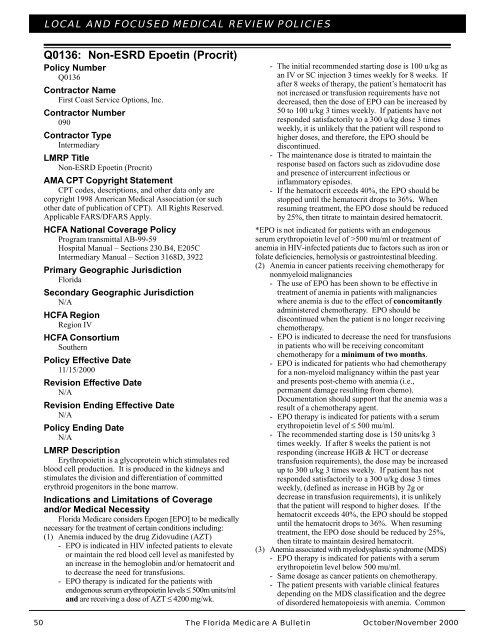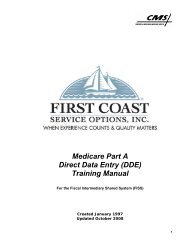Oct-Nov 00 Part A Bulletin - Medicare
Oct-Nov 00 Part A Bulletin - Medicare
Oct-Nov 00 Part A Bulletin - Medicare
Create successful ePaper yourself
Turn your PDF publications into a flip-book with our unique Google optimized e-Paper software.
LOCAL AND FOCUSED MEDICAL REVIEW POLICIES<br />
Q0136: Non-ESRD Epoetin (Procrit)<br />
Policy Number<br />
Q0136<br />
Contractor Name<br />
First Coast Service Options, Inc.<br />
Contractor Number<br />
090<br />
Contractor Type<br />
Intermediary<br />
LMRP Title<br />
Non-ESRD Epoetin (Procrit)<br />
AMA CPT Copyright Statement<br />
CPT codes, descriptions, and other data only are<br />
copyright 1998 American Medical Association (or such<br />
other date of publication of CPT). All Rights Reserved.<br />
Applicable FARS/DFARS Apply.<br />
HCFA National Coverage Policy<br />
Program transmittal AB-99-59<br />
Hospital Manual – Sections 230.B4, E205C<br />
Intermediary Manual – Section 3168D, 3922<br />
Primary Geographic Jurisdiction<br />
Florida<br />
Secondary Geographic Jurisdiction<br />
N/A<br />
HCFA Region<br />
Region IV<br />
HCFA Consortium<br />
Southern<br />
Policy Effective Date<br />
11/15/2<strong>00</strong>0<br />
Revision Effective Date<br />
N/A<br />
Revision Ending Effective Date<br />
N/A<br />
Policy Ending Date<br />
N/A<br />
LMRP Description<br />
Erythropoietin is a glycoprotein which stimulates red<br />
blood cell production. It is produced in the kidneys and<br />
stimulates the division and differentiation of committed<br />
erythroid progenitors in the bone marrow.<br />
Indications and Limitations of Coverage<br />
and/or Medical Necessity<br />
Florida <strong>Medicare</strong> considers Epogen [EPO] to be medically<br />
necessary for the treatment of certain conditions including:<br />
(1) Anemia induced by the drug Zidovudine (AZT)<br />
- EPO is indicated in HIV infected patients to elevate<br />
or maintain the red blood cell level as manifested by<br />
an increase in the hemoglobin and/or hematocrit and<br />
to decrease the need for transfusions.<br />
- EPO therapy is indicated for the patients with<br />
endogenous serum erythropoietin levels ≤ 5<strong>00</strong>m units/ml<br />
and are receiving a dose of AZT ≤ 42<strong>00</strong> mg/wk.<br />
- The initial recommended starting dose is 1<strong>00</strong> u/kg as<br />
an IV or SC injection 3 times weekly for 8 weeks. If<br />
after 8 weeks of therapy, the patient’s hematocrit has<br />
not increased or transfusion requirements have not<br />
decreased, then the dose of EPO can be increased by<br />
50 to 1<strong>00</strong> u/kg 3 times weekly. If patients have not<br />
responded satisfactorily to a 3<strong>00</strong> u/kg dose 3 times<br />
weekly, it is unlikely that the patient will respond to<br />
higher doses, and therefore, the EPO should be<br />
discontinued.<br />
- The maintenance dose is titrated to maintain the<br />
response based on factors such as zidovudine dose<br />
and presence of intercurrent infectious or<br />
inflammatory episodes.<br />
- If the hematocrit exceeds 40%, the EPO should be<br />
stopped until the hematocrit drops to 36%. When<br />
resuming treatment, the EPO dose should be reduced<br />
by 25%, then titrate to maintain desired hematocrit.<br />
*EPO is not indicated for patients with an endogenous<br />
serum erythropoietin level of >5<strong>00</strong> mu/ml or treatment of<br />
anemia in HIV-infected patients due to factors such as iron or<br />
folate deficiencies, hemolysis or gastrointestinal bleeding.<br />
(2) Anemia in cancer patients receiving chemotherapy for<br />
nonmyeloid malignancies<br />
- The use of EPO has been shown to be effective in<br />
treatment of anemia in patients with malignancies<br />
where anemia is due to the effect of concomitantly<br />
administered chemotherapy. EPO should be<br />
discontinued when the patient is no longer receiving<br />
chemotherapy.<br />
- EPO is indicated to decrease the need for transfusions<br />
in patients who will be receiving concomitant<br />
chemotherapy for a minimum of two months.<br />
- EPO is indicated for patients who had chemotherapy<br />
for a non-myeloid malignancy within the past year<br />
and presents post-chemo with anemia (i.e.,<br />
permanent damage resulting from chemo).<br />
Documentation should support that the anemia was a<br />
result of a chemotherapy agent.<br />
- EPO therapy is indicated for patients with a serum<br />
erythropoietin level of ≤ 5<strong>00</strong> mu/ml.<br />
- The recommended starting dose is 150 units/kg 3<br />
times weekly. If after 8 weeks the patient is not<br />
responding (increase HGB & HCT or decrease<br />
transfusion requirements), the dose may be increased<br />
up to 3<strong>00</strong> u/kg 3 times weekly. If patient has not<br />
responded satisfactorily to a 3<strong>00</strong> u/kg dose 3 times<br />
weekly, (defined as increase in HGB by 2g or<br />
decrease in transfusion requirements), it is unlikely<br />
that the patient will respond to higher doses. If the<br />
hematocrit exceeds 40%, the EPO should be stopped<br />
until the hematocrit drops to 36%. When resuming<br />
treatment, the EPO dose should be reduced by 25%,<br />
then titrate to maintain desired hematocrit.<br />
(3) Anemia associated with myelodysplastic syndrome (MDS)<br />
- EPO therapy is indicated for patients with a serum<br />
erythropoietin level below 5<strong>00</strong> mu/ml.<br />
- Same dosage as cancer patients on chemotherapy.<br />
- The patient presents with variable clinical features<br />
depending on the MDS classification and the degree<br />
of disordered hematopoiesis with anemia. Common<br />
50 The Florida <strong>Medicare</strong> A <strong>Bulletin</strong><br />
<strong>Oct</strong>ober/<strong>Nov</strong>ember 2<strong>00</strong>0





